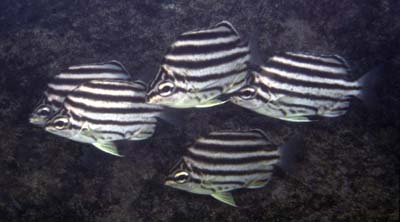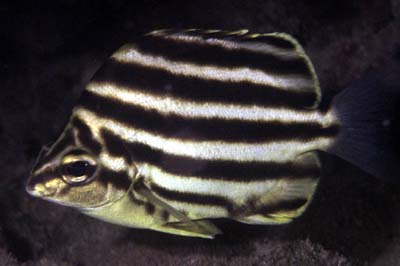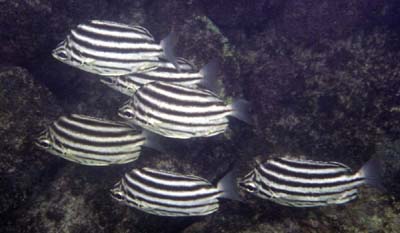| hawaiisfishes.com |
|
Home |
Fishes | Invertebrates |
Books | CDs
| Links |
Contact |
|
past
fishes of the month STRIPEY
|
 Lydgate State Park, Kaua`i. 3 ft. |
| STRIPEY Microcanthus strigatus (Cuvier, 1831) Here is a distinctive Hawaiian fish that almost no one sees. It's not exactly rare--you just have to know where to look. I first read about this species in Tinker's Fishes of Hawai`i. Tinker reports that the young "are found in the shallow waters of the shore line in April and May and move into the deeper water on the outer side of the reef as they mature." Dr. Randall's Guide to Hawaiian Reef Fishes says that "the young can be caught in tide pools from December to April." Gosline and Brock in their Handbook of Hawaiian Fishes state that the species is "not uncommon in certain shallow water areas." Now I had spent a lot of time peering into tide pools and had never seen a Stripey. Nor had I ever seen one in deeper water beyond the reef. And in all my hours spent snorkeling in shallow water I had not seen any stripeys at all. Not one, ever. I asked other divers, but no one was seeing these 6-inch fish with the bold diagonal stripes. I mean if you saw one of these guys you could hardly miss it, could you? So where are the stripeys? All the fish books said they are here. I was desperate to find one. Finally my wish was granted. While on Kauai to photograph Whiskered Boarfish I asked Linda Bail of Bubbles Below Scuba Charters where I could find stripeys. “Lydgate State Park” she told me. I went there and sure enough, along the rocky breakwater on the seaward side of the shallow snorkeling lagoon I was thrilled to find dozens of stripeys. The kids were feeding them bits of bread. (There was even a small morwong back in the rocks too, another first for me at the time.) |
|
|
 Mokule`ia, O`ahu. 8 ft. |
|
Three species or one? |
|
Home | Fishes | Invertebrates | Books | CDs | Links | Contact Text and photos copyright John P. Hoover |
